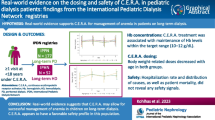Summary
Epoetin (recombinant human erythropoietin: EPO) therapy adds a significant cost to the management of end-stage renal disease, the majority of the extra expense being attributable to its acquisition cost. In a Japanese multicentre, randomised, prospective study, a significant dose-dependent response was documented with epoetin given subcutaneously (SC) once a week or once every 2 weeks to patients receiving continuous ambulatory peritoneal dialysis. Three different dosages were studied over 5 months in patients with a haematocrit (Hct) of 0,28 or less. namely 6000U (107 U/kg), 9000U ( 167 U/kg) and 12 000U (211 U/kg). Epoetin was given weekly for the first 2 months until the target Hcl value of 0.33 was reached.
The rates of response were 81. 85 and 100% with the 6000U, 9000U and 12 000U regimens, respectively. Subsequently responders were maintained at the target Hct for an additional 3 months, with the administration frequency eventually being reduced to fortnightly or 4-weekly. Patients in the epoetin 6000U and 9000U groups who did not respond after 2 months’ treatment underwent induction and maintenance with the 12 000U regimen.
During the maintenance phase, patients receiving the epoetin 6000U and 9000U dosages required weekly (54 and 64%, respectively) or fortnightly (46 and 36%, respectively) injections. Patients receiving the 12 000U regimen were found to require weekly (9%), fortnightly (73%) or 4-weekly (18%) injections.
Using these data, we performed a decision analysis that quantitatively incorporated the probability of attaining and maintaining target Hct levels in all patients (i.e. the effectiveness of epoetin), and direct costs as a function of both cumulative doses and injections required in all 3 strategies over 5 months.
Decision analysis indicated that the most cost-effective SC epoetin strategy in patients undergoing peritoneal dialysis is epoetin 6000U weekly for 2 months, followed by maintaining the target Hct with weekly or 2-weekly epoetin 6000U for the next 3 months. Nonresponders should restart epoetin therapy using the 12000U strategy. The 9000U and 12 000U strategies were associated with similar costs, because the economic advantages associated with the lower administration frequency of the 9000U regimen compared with the 6000U regimen were offset by its higher cumulative acquisition cost. In other words, decision analysis indicated that the most cost-effective strategy was to use the lowest effective dose, reserving the highest dosage for patients who do not respond after 2 months.
The superiority of this strategy was confirmed by a sensitivity analysis performed on the cost of drug administration, which was varied from zero to $US60 per dose. In addition, consistent results were obtained when the analysis was extended to cover a 1-year treatment period with all 3 strategies.
Similar content being viewed by others
References
Whittington R, Barradell LB, Benfield P. Epoetin: a pharmacoeconomic review of its use in chronic renal failure and its effects on quality of life. Pharmacoeconomics 1993; 3 (1): 45–82
Stevens ME, Summerfield GP, Hall AA, et al. Cost–benefits of low dose subcutaneous erythropoiet in patients with anaemia of end stage renal disease. BMJ 1992: 304: 474–7
McNamee P, van Doorslaer E, Segaar R, Benefits and costs of recombinant human erythropoietin for end stage renal failure: a review. Int J Technol Assess Health Care 1993: 9: 490–504
Eschbach JW. Erythropoietin: the promise and the facts. Kidney Int 1994; 45 Suppl. 44: 70–6
Besarab A. Optimizing epoetin therapy in end–stage renal disease: the case for subcutaneous administration. Am J Kidney Dis 1993; 22 Suppl.1; 13–22
Abraham PA. Health care payment policies: lessons from erythropoietin. Am J Kidney Dis 1993: 22: 596–7
Sisk JE, Gianfrancesco FD, Coster JM. Recombinant erythropoietin and medicare payment. JAMA 1991; 266: 247–52
Thomas M, Saker BM, Thatcher GN, et al. Cost–effectiveness of weekly and fortnightly subcutaneous erythropoietin. Lancet 1990: 335: 1533–4
Nomoto Y, Kawaguchi Y, Kubota M, et al. A multicenter study with once a week or once every two weeks high–dose subcutaneous administration of recombinant human erylhropoietin in continuous ambulatory peritoneal dialysis. Peril Dial Int 1994; 14: 56–60
Weinstein MC, Fineberg HV, Elstein AS, et al. Clinical decision analysis. Philadelphia: Saunders, 1980
Sonnenberg FA, Pauker SG. Decision Maker. Version 6.2. Operating manual. Boston: New England Medical Center, 1988
Lui SF, Law CB, Ting SM, et al. Once weekly versus twice weekly subcutaneous administration of recombinant human erythropoietin in patients on continous ambulatory peritoneal dialysis. Clin Nephrol 1991: 36: 246–51
Lui SF, Wong KC, Li PKT, et al. Once weekly versus twice weekly subcutaneous administration of recombinant human erythropoietin in haemodialysis patients. Am J Nephrol 1992; 12: 55–60
Austrian Multicenter Study Group of r–HUEPO in Predialysis Patients. Nephron 1992; 61: 399–403
Author information
Authors and Affiliations
Rights and permissions
About this article
Cite this article
Piccoli, A., Puggia, R.M., Fusaro, M. et al. A Decision Analysis Comparing Three Dosage Regimens of Subcutaneous Epoetin in Continuous Ambulatory Peritoneal Dialysis. Pharmacoeconomics 7, 444–456 (1995). https://doi.org/10.2165/00019053-199507050-00008
Published:
Issue Date:
DOI: https://doi.org/10.2165/00019053-199507050-00008




